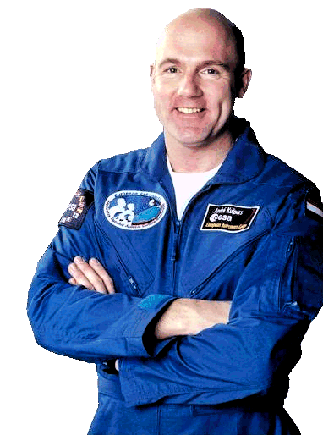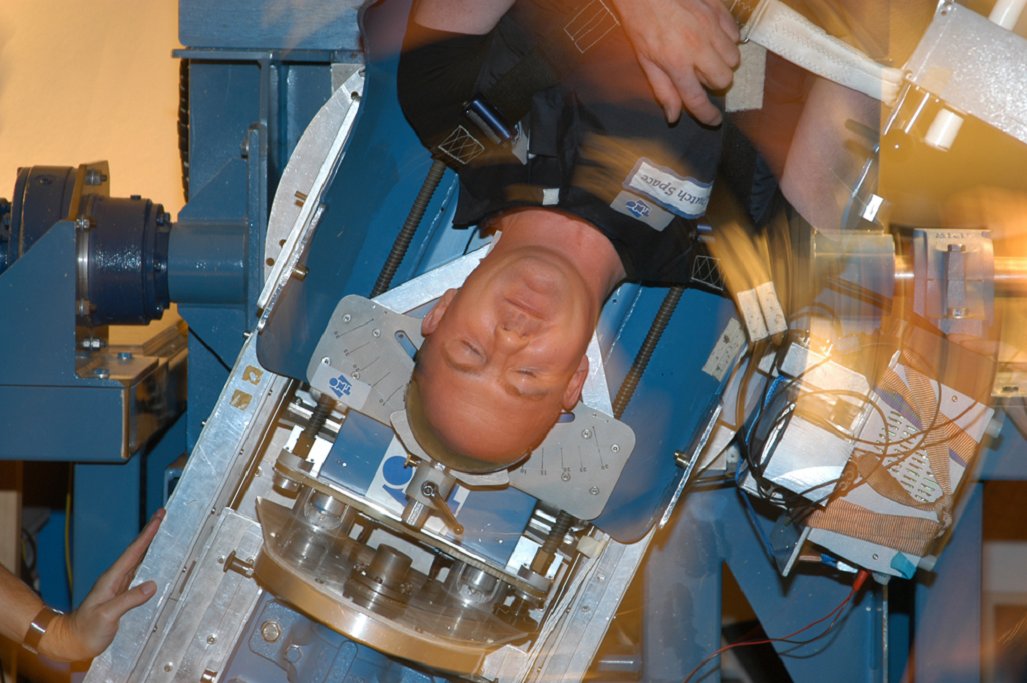
|
SUIT
|

|
Abstract:
Astronauts are not always aware of their
orientation due to the lack of gravity. In the International Space Station,
astronauts determine their orientation on the basis of visual cues as far as
they are available. The presentation of a tactile orientation cue can enlarge
the orientation awareness of the astronaut and therefore his performance, safety
and comfort. During his mission to the ISS, an ESA astronaut will extensively
test this principle of a tactile orientation cue. The concept is based on presenting
an artificial gravity vector as a location on the torso.
We developed the concept and a model to support the astronaut with a tactile
display consisting of 56 vibrating elements on the torso. The location of vibration
intuitively presents where down is in the reference frame the astronaut chooses.
On the basis of the specifications we formulated, Dutch Space in Leiden built a space-rated tactile vest.
At TNO Human Factors, we have worked out two experiments, including a specific
taskbattery, and wrote the in-flight and training procedures. The taskbattery
consists of five tasks that will be completed in different conditions and will
be repeated on several days during the mission so we can study the effects of
adaptation to microgravity. The pilot studies that we did with the astronaut
and his subjective evaluation are promising.
The knowledge we gather in the present
experiment is of eminent importance for the development and applications of
tactile displays for orientation task, such as the displays we develop for military
pilots. Other (military) applications to which we expect a spin-off are divers,
soldiers, visually handicapped, emergency services, and the automobile and sport
industry.
Address corresponding
author:
Jan B.F. van Erp, TNO Human
Factors, Kampweg 5, PO Box 23, 3769 ZG Soesterberg, The Netherlands, Vanerp@tm.tno.nl, +31 346 356 458 (voice),
+31 346 353 977 (fax)
Payload Developer:
Dutch Space, Newtonweg 1, Leiden,
The Netherlands, Phone +31 (0) 71 524 5716, Fax +31 (0) 71 524 5499
Introduction: SUIT is a tactile display that tells the astronauts where down is. The display developed for André Kuipers consists of 56 small vibrating elements (like those in mobile phones) attached to the torso in a matrix form. The location of vibration indicates the direction of ‘down’, like an artificial gravity vector. Since the localised vibration of an element is directly mapped to the body coordinates, the vibrating vest is an intuitive and fast way to present spatial information (this is also known as the "tap on the shoulder" principle). The user can choose his own reference system, that is, decide what up and down is. The astronaut’s orientation is accurately measured by three gyroscopes integrated in the vest. The concept behind SUIT and the experiments are developed by TNO Human Factors in Soesterberg, The Netherlands with financial support from TNO and The Royal Netherlands Air force The hardware is built by Dutch Space, The Netherlands, on specifications of TNO and financed by NIVR and the Ministry of Economic Affairs.

Figure 1: The artificial gravity vector
metaphor ‘translates’ down into a location on the astronaut’s torso.
The arrow represents a fixed rfeference atfificial gravity vector.
Rationale: In everyday life, we gather information
about the world around us via different sensory systems, including our proprioceptive
and cutaneous senses. When the information that comes through one of our senses
is degraded, for example when wearing protective earphones, our performance
and comfort will be negatively affected. A microgravity environment not only
degrades but even lacks specific sensory information. Especially the proprioceptive
and cutaneous senses are affected. For example, there is no pressure on the
sole of the feet when standing, and there are no g-forces to overcome when positioning
limbs or that pulls clothing to the skin. This sensory deprivation affects the
way astronauts perceive their subjective vertical. In Earth’s 1G environment,
we use four cues to determine the subjective vertical: visual cues, vestibular
cues, proprioceptive cues and our ideotropic vector (i.e., we are inclined to
see our own body axis as vertical). On board the ISS, vestibular and proprioceptive
cues are absent.
We hypothesise that providing additional orientation information will enhance
the astronauts comfort, safety and performance.
More specifically, we expect that SUIT:

André Kuipers tests the vest in the TNO rotating chair in November 2003.
Experiment: The
final experiment schedule is still to be determined by the parties involved.
The plan is to test SUIT in two different kinds of experiments. The first is
a specific taskbattery that is focussed on gathering scientific data. The second
is a usability study in which André uses the vest during his daily life activities
to evaluate its use as a support tool.
The task battery will be performed for several days during the mission, among
other things to test effects of adaptation. André will do the taskbattery in
different conditions, for example with eyes open and closed and with the SUIT
support on and off. The taskbattery will result in scientific data on path integration,
adaptation to rotation, spatial awareness and multimodal integration. We measure
objective performance (such as reaction times based on the data stored on memory
cards integrated with SUIT) and perform a subjective evaluation by means of
questionnaires.
Spin-in and pin-off : The major impulse for the recent developments for tactile torso displays for orientation and navigation comes from the military cockpit. However, we expect that not only astronauts and pilots can benefit from this innovative development. Spin-off is foreseen for for instance divers and people with a vestibular disorder. A simpler variant (e.g., a belt around the torso) could be very useful as a navigation display for visually handicapped, for drivers who need to keep their eyes on the road, and for firefighters who operate in smoke, dust or darkness